Vectors and Newton's law of Motion | Basic Physics for IIT JAM PDF Download
| Table of contents |

|
| What are Scalars? |

|
| What are Vectors? |

|
| Vector Operations |

|
| Component Form: Vector Algebra |

|
| What are Triple Products? |

|
| Newton's Law of Motion |

|
What are Scalars?
Scalar quantity is defined as the physical quantity that has magnitude but no direction.
- It can be represented by a number only. Example: Mass = 4 kg
- The magnitude of mass = 4, Unit of mass = kg
- Scalar quantities can be added, subtracted, and multiplied by simple law of algebra.
- Examples of Scalar Quantities include mass, speed, distance, time, area, volume, density & temperature.
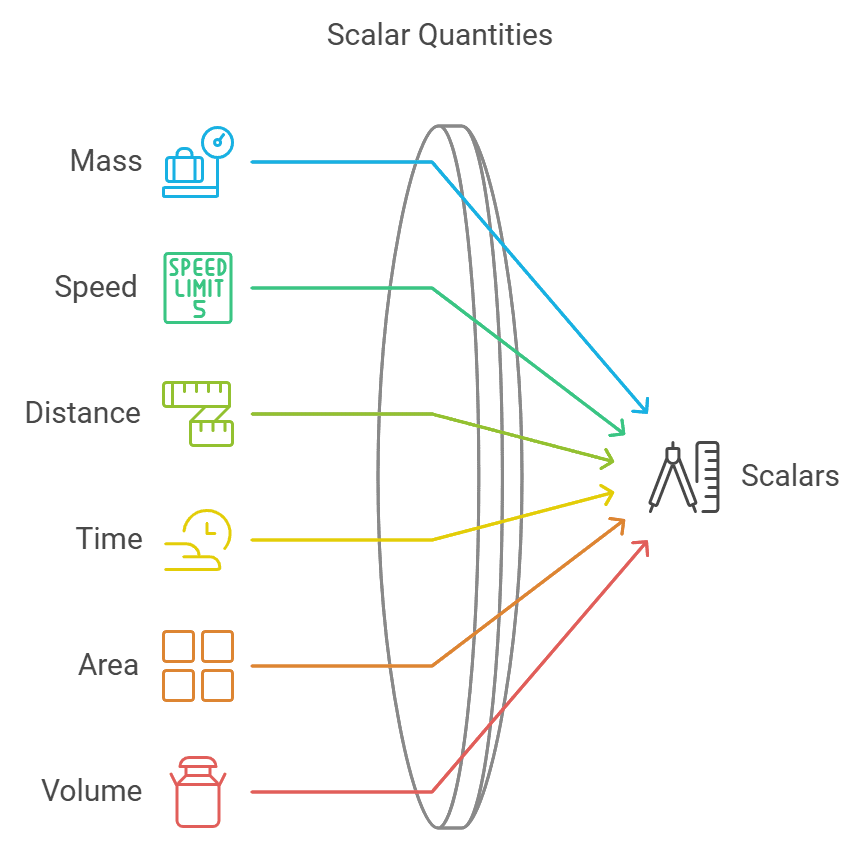
What are Vectors?
A vector quantity is defined as the physical quantity that has both direction as well as magnitude and follows law of vector addition.
 Vectors
Vectors
For example, Speed = 4 m/s (is a scalar), Velocity = 4 m/s toward north (is a vector).
- The magnitude of a vector is the absolute value of a vector and is indicated by |A|.
- Example of Vector quantity: Displacement, velocity, acceleration, force, etc.
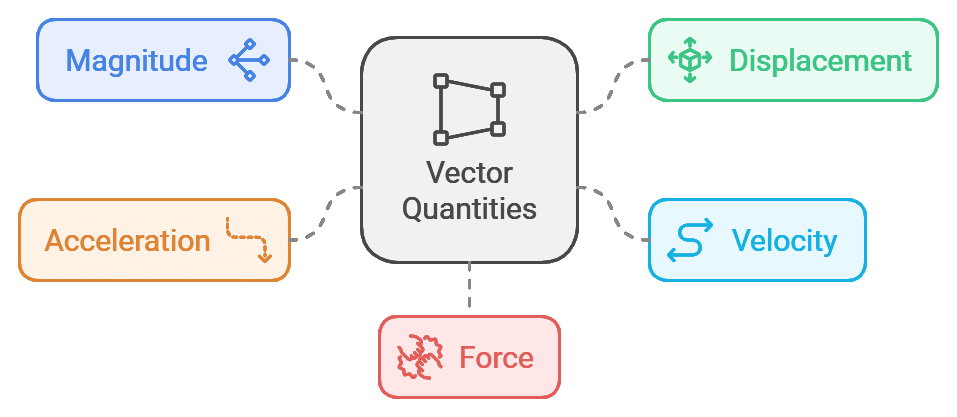
Differences between scalar and vector quantities are mentioned in the table below:
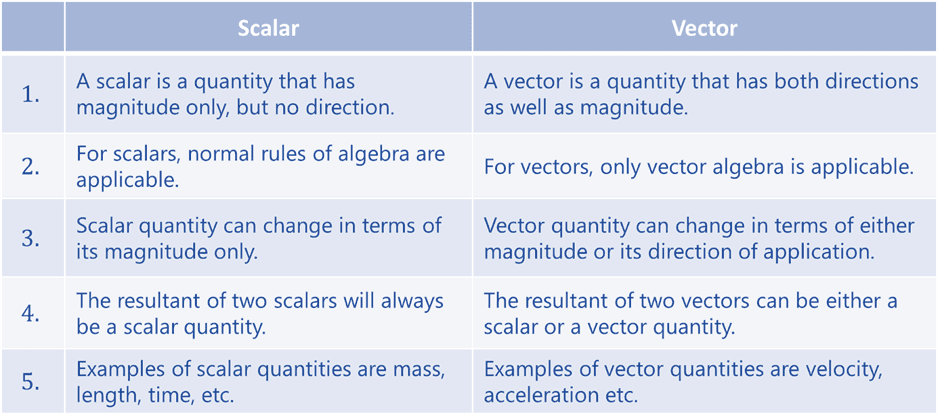
Vector Operations
(i) Addition of two vectors
- Place the tail of
 at the head of
at the head of  ; the sum
; the sum  is the vector from the tail of
is the vector from the tail of  to the head of
to the head of 
- Addition is commutative:

- Addition is associative:

- To subtract a vector, add its opposite


(ii) Multiplication by scalar
Multiplication of a vector by a positive scalar a, multiplies the magnitude but leaves the direction unchanged. (If a is negative, the direction is reversed.)
Scalar multiplication is distributive:
(iii) Dot product of two vectors
The scalar product of two vectors is equal to the product of their magnitudes and the cosine of the smaller angle between them.
It is denoted by.(dot). The scalar or dot product of two vectors is a scalar.
A . B = AB cos θ
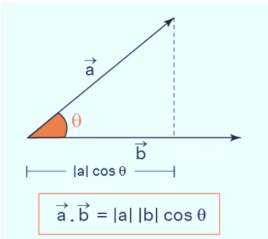
Properties of Scalar Product:
- Scalar product is commutative, i.e.,

- Scalar product is distributive, i.e.,

- Scalar product of two perpendicular vectors is zero.
A . B = A B cos 90° = 0 - Scalar product of two parallel vectors is equal to the product of their magnitudes, i.e., A . B = AB cos 0° = AB
- Scalar product of a vector with itself is equal to the square of its magnitude, i.e.,
A . A = A A cos 0° = A2 - Scalar product of orthogonal unit vectors is zero and Scalar product in cartesian coordinates is given by AxBx + AyBy + AzBz .
Law of Cosines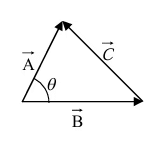
Let  and then calculate the dot product of
and then calculate the dot product of  with itself.
with itself.

(iv) Cross-product of two vectors
The vector product of two vectors is equal to the product of their magnitudes and the sine of the smaller angle between them. It is denoted by X (cross).

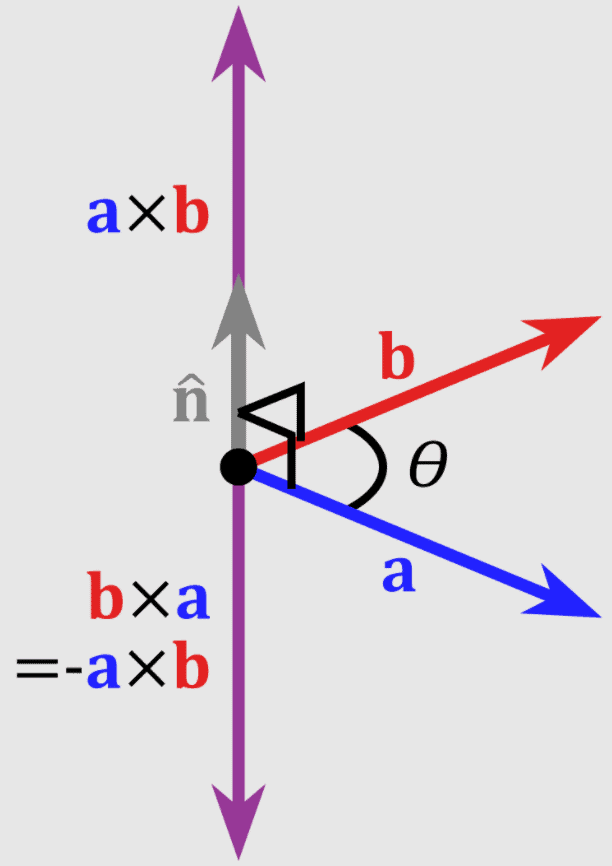 Vector Cross Product
Vector Cross Product
- The direction of unit vector n can be obtained from the right-hand thumb rule.
- If fingers of right hand are curled from A to B through a smaller angle between them, then the thumb will represent the direction of vector (A X B).
- The vector or cross product of two vectors is also a vector.
Properties of Vector Product:
- Vector product is not commutative, i.e.,
A X B ≠ B X A [ therefore, (A X B) = - (B X A)] - Vector product is distributive, i.e.,
A X (B + C) = A X B + A X C - The vector product of two parallel vectors is zero, i.e.,
A X B = A B sin 0° = 0 - The vector product of any vector with itself is zero.
A X A = A A sin 0° = 0 - On moving in a clockwise direction and taking the cross product of any two pair of the unit vectors we get the third one and in an anticlockwise direction, we get the negative resultant.
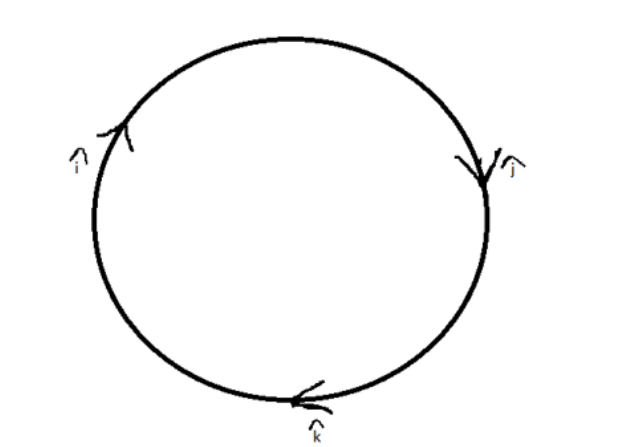
The following results can be established:
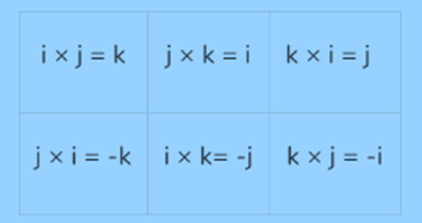
Direction of Vector Cross Product
- When C = A X B, the direction of C is at right angles to the plane containing the vectors A and B. The direction is determined by the right-hand screw rule, and right-hand thumb rule.
- Right-Hand Thumb Rule: Curl the fingers of your right hand from A to B. Then, the direction of the erect thumb will point in the direction of A X B.
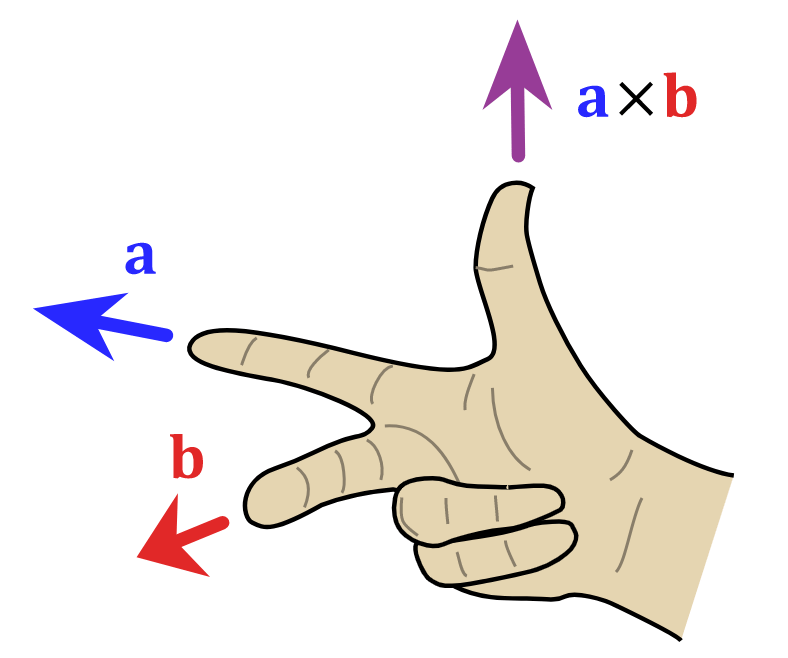 Right Hand Thumb Rule
Right Hand Thumb Rule - Right-Hand Screw Rule: It is also known as Maxwell's Screw Rule, a simple and visual way to determine the direction of a magnetic field or angular motion in relation to a current or rotation.
Explanation: - Imagine holding a screw and turning it with a screwdriver.
- The direction in which you turn the screw (clockwise or counterclockwise) is the direction of rotation.
- The direction in which the screw moves (up or down along the axis) corresponds to the direction of the current or the magnetic field.
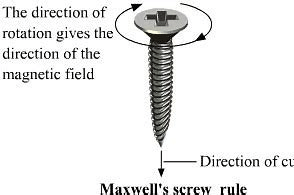
Component Form: Vector Algebra
Let  and
and  be unit vectors parallel to the x, y, and z axis, respectively. An arbitrary vector
be unit vectors parallel to the x, y, and z axis, respectively. An arbitrary vector  can be expanded in terms of these basis vectors
can be expanded in terms of these basis vectors

The numbers 
 are called components of
are called components of  ; geometrically, they are the projections of
; geometrically, they are the projections of  along the three coordinate axes.
along the three coordinate axes.
Rule 1:To add vectors, add like components.

Rule 2: To multiply by a scalar, multiply each component.
 Because
Because  are mutually perpendicular unit vectors,
are mutually perpendicular unit vectors, 
Accordingly, 
Rule 3: To calculate the dot product, multiply like components, and add.
In particular, 
Similarly,
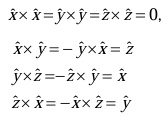
Rule 4: To calculate the cross product, form the determinant whose first row is
whose second row is
(in component form), and whose third row is
.

Example 1: Find the angle between the face diagonals of a cube.

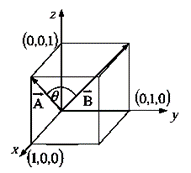
What are Triple Products?
Since the cross product of two vectors is itself a vector, it can be dotted or crossed with a third vector to form a triple product.
(i) Scalar triple product: 
Geometrically  the volume of the parallelepiped generated by
the volume of the parallelepiped generated by  since
since  is the area of the base, and
is the area of the base, and  is the altitude.
is the altitude.
Evidently, 

Note that the dot and cross can be interchanged:
(ii) Vector triple product: 
The vector triple product can be simplified by the so-called BAC-CAB rule: 
Newton's Law of Motion
Newton's Laws of Motion are three fundamental principles that underpin classical mechanics. These laws explain how a body interacts with the forces acting upon it and how it moves as a result of those forces.
1. First Law (Law of Inertia)
The first law states that if the net force acting on an object (the total of all forces) is zero, the object's momentum remains constant in both size and direction.
- Inertia is a basic property of matter that resists any change in its state of motion. It is generally measured by mass; the larger the mass, the greater the inertia.
- An inertial frame is a coordinate system with a clock that moves at a constant speed. Within such a frame, if no external force acts on an object, it will either stay at rest or continue to move at a constant velocity.
- Mathematically, the first law can be represented as:

2. Second Law
The second law states that the net force on an object is equal to the rate of change (that is, the derivative) of its linear momentum
in an inertial reference frame i.e.

If the mass is constant then the vector sum of the external forces  on an object is equal to the mass m of that object multiplied by the acceleration vector
on an object is equal to the mass m of that object multiplied by the acceleration vector  of the object
of the object 

One can visualize Newton’s second law as cause and effect phenomenon where external force is equivalent to cause and resulting acceleration is its effect which is measured by a force.
In the case when the velocity is very high (close to velocity of light) Newton’s law should be modified according to special theory of relativity.
3. Third Law
The third law states that "To every action there is an equal and opposite reaction".
The action and reaction acts on two different bodies.
Consider two bodies body one exerts a force  on second body and the second body simultaneously exerts a force
on second body and the second body simultaneously exerts a force  equal in magnitude and opposite in direction on the first body
equal in magnitude and opposite in direction on the first body 
To summarise, here is the flowchart:
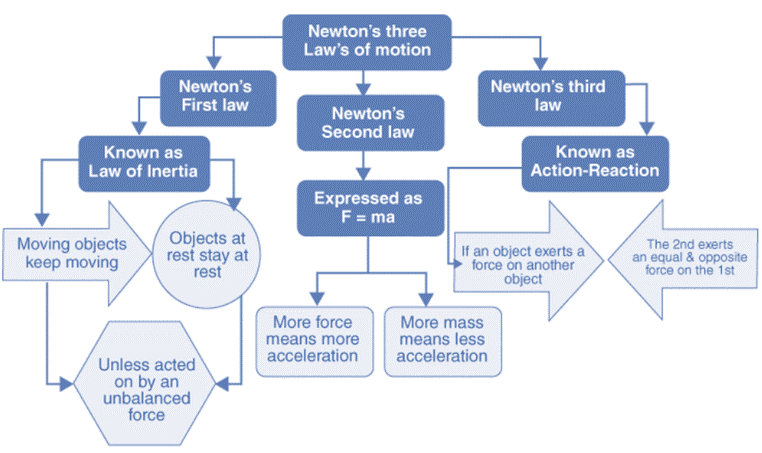
|
217 videos|156 docs|94 tests
|
FAQs on Vectors and Newton's law of Motion - Basic Physics for IIT JAM
| 1. What is the difference between scalars and vectors? |  |
| 2. How do you perform vector addition? |  |
| 3. What is the component form of a vector? |  |
| 4. What are the triple products in vector algebra? |  |
| 5. How do vectors relate to Newton's laws of motion? |  |

















